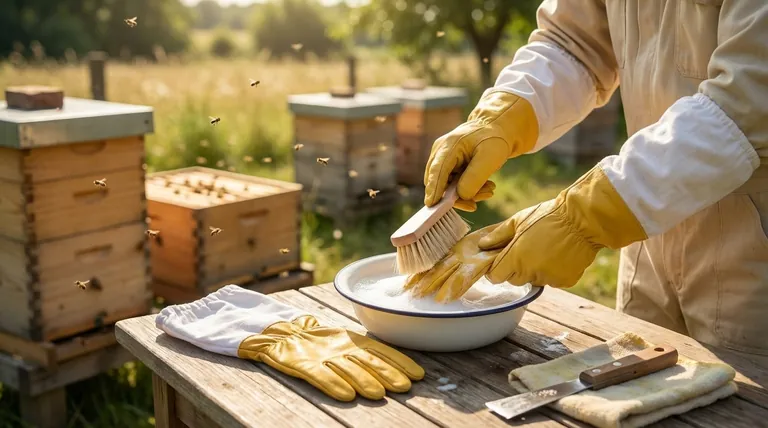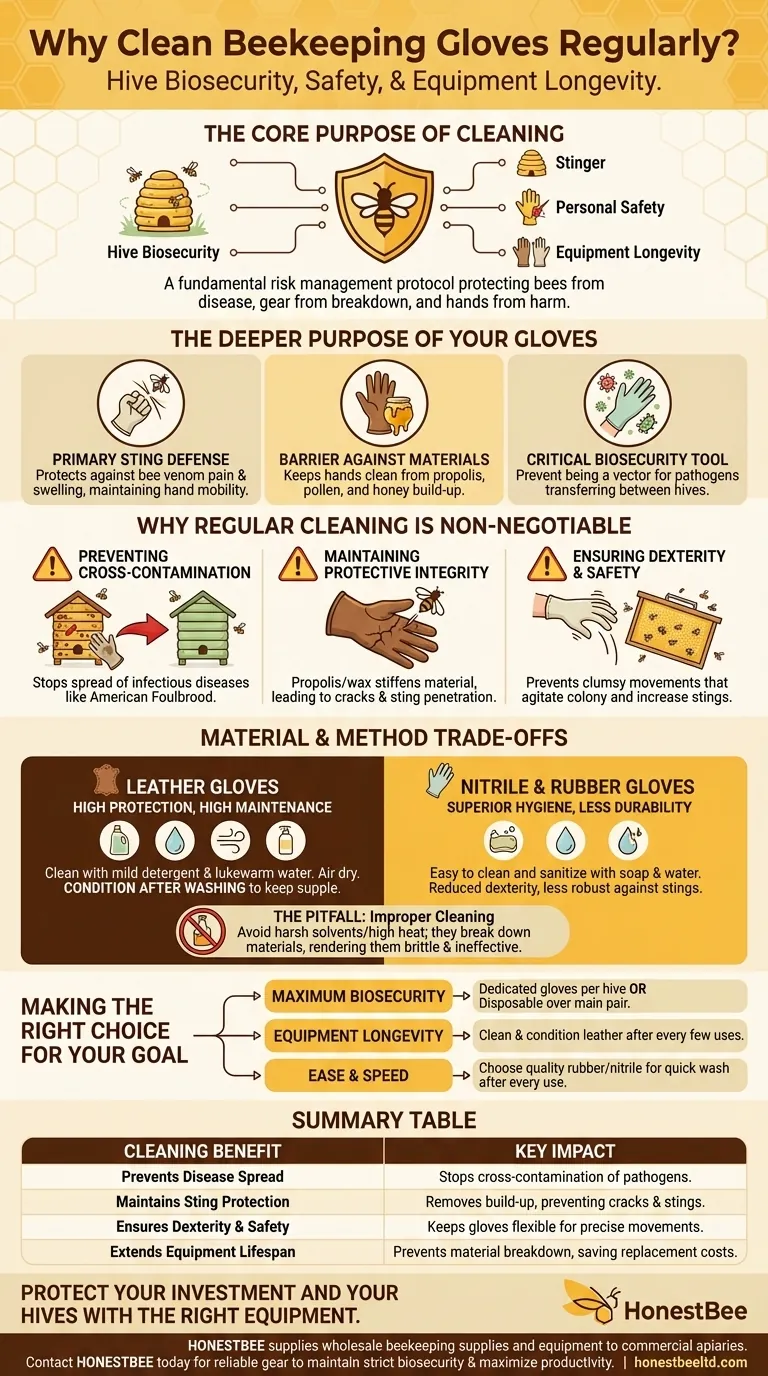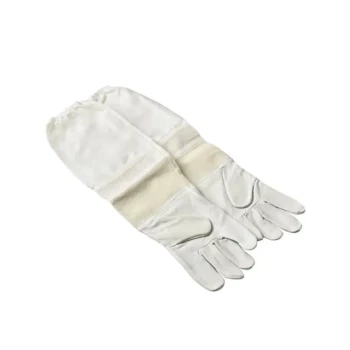At its core, cleaning your beekeeping gloves is a critical practice for hive biosecurity, personal safety, and equipment longevity. Dirty gloves can act as a vehicle for transmitting devastating diseases between your hives, while accumulated propolis and wax can stiffen the material, compromising your dexterity and the gloves' protective integrity against stings.
Glove cleaning is not merely about tidiness. It is a fundamental risk management protocol that protects your bees from disease, preserves the functional lifespan of your gear, and ensures your hands remain safe and agile during delicate hive inspections.

The Deeper Purpose of Your Gloves
Before discussing cleaning, it's vital to understand the multiple roles your gloves play. They are far more than a simple barrier; they are a multifunctional tool.
Primary Defense Against Stings
The most obvious purpose of beekeeping gloves is to protect your hands from stings. Bee venom can cause pain and swelling, which reduces hand mobility and the fine motor skills necessary for careful hive manipulation.
A Barrier Against Hive Materials
Gloves keep your hands clean from sticky honey, pollen, and especially propolis. This resinous substance can be difficult to remove from skin and can build up on gloves, affecting their performance.
A Critical Tool for Biosecurity
Most importantly, your gloves are a potential vector for pathogens. Spores and bacteria from an infected hive can easily cling to the surface of a glove and be transferred to a healthy colony during your next inspection.
Why Regular Cleaning is Non-Negotiable
Failing to clean your gloves has direct consequences for your bees, your equipment, and your own safety.
Preventing Cross-Contamination
This is the single most important reason to clean your gloves. Diseases like American Foulbrood (AFB) are highly infectious, and moving from one hive to another with contaminated gloves is a primary way beekeepers unknowingly spread pathogens through an apiary.
Maintaining Protective Integrity
Propolis and wax build-up will cause leather gloves to become stiff and inflexible over time. This rigidity can lead to cracks in the material, creating weak points where a bee's stinger can penetrate.
Ensuring Dexterity and Safety
Stiff, sticky gloves significantly reduce your dexterity. Clumsy movements can lead you to drop a frame, crush bees, or make sudden gestures that agitate the colony, increasing the likelihood of a defensive response and more stings.
Understanding the Trade-offs: Material and Method
The right cleaning method depends entirely on your glove material. Using the wrong technique can do more harm than good.
Leather Gloves: High Protection, High Maintenance
Leather offers excellent sting protection and durability. However, it requires careful cleaning with a mild detergent and lukewarm water, followed by air-drying away from direct heat. Most critically, leather must be conditioned after washing to restore oils and keep it supple.
Nitrile & Rubber Gloves: Superior Hygiene, Less Durability
These materials are extremely easy to clean and sanitize, making them an excellent choice for strict hygiene protocols. They can be washed thoroughly with soap and water. The trade-off is often reduced dexterity and less robust protection against stings compared to thick leather.
The Pitfall of Improper Cleaning
Never use harsh chemical solvents or high heat to clean or dry your gloves. These methods will break down the materials, whether leather or synthetic, rendering them brittle and ineffective as a protective barrier. Always follow the manufacturer's specific care instructions.
Making the Right Choice for Your Goal
Your glove care routine should be a deliberate part of your beekeeping strategy, tailored to your specific priorities.
- If your primary focus is maximum biosecurity: Use dedicated gloves for each apiary or hive, or wear disposable nitrile gloves over your main pair and change them between hives.
- If your primary focus is equipment longevity: Clean and condition your leather gloves after every few uses to keep them pliable, ensuring they last for many seasons.
- If your primary focus is ease and speed: Choose high-quality rubber or nitrile gloves that can be quickly and thoroughly washed after every single use.
By viewing glove maintenance as a key element of hive health, you shift from being a keeper of bees to a manager of a healthy apiary ecosystem.
Summary Table:
| Cleaning Benefit | Key Impact |
|---|---|
| Prevents Disease Spread | Stops cross-contamination of pathogens like American Foulbrood between hives. |
| Maintains Sting Protection | Removes propolis/wax that stiffens material, preventing cracks and sting penetration. |
| Ensures Dexterity & Safety | Keeps gloves flexible for precise movements, reducing agitation and stings. |
| Extends Equipment Lifespan | Proper cleaning and conditioning prevents material breakdown, saving on replacement costs. |
Protect Your Investment and Your Hives with the Right Equipment
Proper glove care is just one part of a successful, hygienic beekeeping operation. Equip your apiary with durable, high-performance supplies designed for commercial demands.
HONESTBEE supplies beekeeping supplies and equipment to commercial apiaries and beekeeping equipment distributors through wholesale-focused operations. We provide the reliable gear you need to maintain strict biosecurity and maximize productivity.
Contact HONESTBEE today to discuss your wholesale needs and discover how our equipment can support a healthier, more profitable beekeeping business.
Visual Guide

Related Products
- Beekeeping Gloves Goatskin Leather with Long Cotton Sleeve for Beekeepers
- Goatskin Leather Beekeeper Gloves with Vent Long Sleeve for Beekeeping Honey Bee Sting Proof Protection
- Goat Skin Leather Bee Sting Proof Beekeeping Gloves with Canvas Sleeve
- Mesh Ventilated 3 Layer Goatskin Beekeepers Gloves for Beekeeping
- Professional Beekeeping Suit for Kids and Girls Childrens Bee Keeper Suit
People Also Ask
- What is the difference between cleaning cow leather and goat leather beekeeping gloves? Tailor Your Care for Longevity
- What are the advantages of goatskin leather gloves for beekeeping? Superior Sting Protection for Your Apiary
- Should beekeepers wear gloves, and why? Essential Protection for Beekeepers
- Why are protective gloves important in beekeeping? Boost Confidence & Safety in Your Apiary
- Why is dexterity and flexibility important in beekeeping gloves? Boost Your Hive Management Efficiency



















